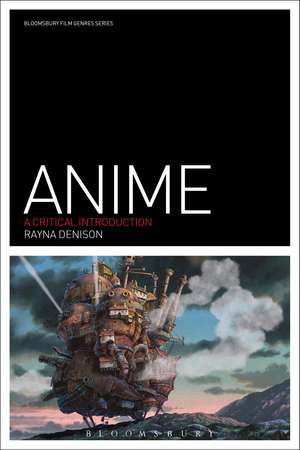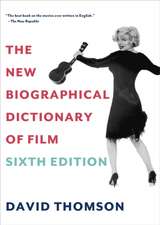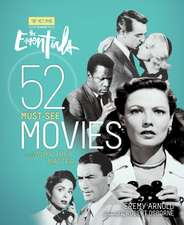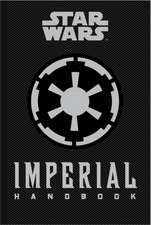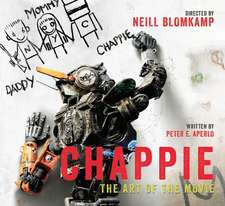Anime: A Critical Introduction: Film Genres
Autor Rayna Denisonen Limba Engleză Paperback – 21 oct 2015
| Toate formatele și edițiile | Preț | Express |
|---|---|---|
| Paperback (1) | 184.59 lei 3-5 săpt. | +55.12 lei 6-10 zile |
| Bloomsbury Publishing – 21 oct 2015 | 184.59 lei 3-5 săpt. | +55.12 lei 6-10 zile |
| Hardback (1) | 655.74 lei 6-8 săpt. | |
| Bloomsbury Publishing – 21 oct 2015 | 655.74 lei 6-8 săpt. |
Preț: 184.59 lei
Preț vechi: 227.48 lei
-19% Nou
Puncte Express: 277
Preț estimativ în valută:
35.33€ • 38.36$ • 29.67£
35.33€ • 38.36$ • 29.67£
Carte disponibilă
Livrare economică 02-16 aprilie
Livrare express 18-22 martie pentru 65.11 lei
Preluare comenzi: 021 569.72.76
Specificații
ISBN-13: 9781847884794
ISBN-10: 1847884792
Pagini: 200
Ilustrații: 17 bw illus
Dimensiuni: 156 x 234 x 15 mm
Greutate: 0.32 kg
Editura: Bloomsbury Publishing
Colecția Bloomsbury Academic
Seria Film Genres
Locul publicării:London, United Kingdom
ISBN-10: 1847884792
Pagini: 200
Ilustrații: 17 bw illus
Dimensiuni: 156 x 234 x 15 mm
Greutate: 0.32 kg
Editura: Bloomsbury Publishing
Colecția Bloomsbury Academic
Seria Film Genres
Locul publicării:London, United Kingdom
Caracteristici
Introduces a new understanding of anime, rooted for the time in research and theoretical contexts, rather than solely textual, individualized case studies
Notă biografică
Rayna Denison is Lecturer in Media Studies at the University of East Anglia, UK, specializing in Japanese and Asian film and television cultures. After reading Japanese Studies at Oxford University, Rayna completed and MA and PhD in Film Studies at the University of Nottingham. She has recently completed a UK Research Council-funded project on the links between manga and filmmaking in contemporary Japan, and her publications include a range of articles in journals like Animation, the International Journal of Cultural Studies and Japan Forum.
Cuprins
Introduction Chapter 1: Approaching Anime: Genre and Subgenres Chapter 2: Sci Fi Anime: Cyberpunk to Steampunk Chapter 3: Anime's Bodies Chapter 4: Early Anime Histories: Japan and America Chapter 5: Anime, Video and the Shojo and Shonen Genres Chapter 6: Post-Video Anime: Digital Media and the Revelation of Anime's Hidden Genres Chapter 7: Ghibli Genre: Toshio Suzuki and Studio Ghibli's Brand Identity Chapter 8: Experiencing Japan's Anime: Genres at the Tokyo International Anime Fair Chapter 9: Anime Horror and Genrification Index
Recenzii
A brilliant encapsulation of the vast range of anime, from its history to the digital era. For anyone wondering what all the fuss is about this is the place to begin, and for those already turned on to the wonders of the form this will point you in new directions for both viewing and study.
In this lively and readable book, Rayna Denison frames Japanese animation in relation to local and transnational genres from science fiction through to horror. This is, quite simply, the best scholarly introduction to anime that I have read.
In the complicated world of anime studies, where definitions clash over anime's relation to culture, technology, and media, Rayna Denison clears up the field by focusing on the field itself, skillfully using concepts from genre studies to reveal how anime has been constructed in history through the discourse of fans, critics, and producers not only through genres such as science fiction and horror, but as a fascinating and flexible genre itself.
This slender volume packs an interesting punch: it looks at the very concept of anime itself, outlining both its history within Japan and how it has been received and perceived in the USA and the UK. Written with admirable clarity, it examines some key examples in order to illustrate the complexity of the genres that get included under the umbrella term anime. Anime: A Critical Introduction has all the hallmarks of a teaching classic-one for all of us to add to our reading lists whether in Japanese Studies or Film and Cultural Studies.
In this lively and readable book, Rayna Denison frames Japanese animation in relation to local and transnational genres from science fiction through to horror. This is, quite simply, the best scholarly introduction to anime that I have read.
In the complicated world of anime studies, where definitions clash over anime's relation to culture, technology, and media, Rayna Denison clears up the field by focusing on the field itself, skillfully using concepts from genre studies to reveal how anime has been constructed in history through the discourse of fans, critics, and producers not only through genres such as science fiction and horror, but as a fascinating and flexible genre itself.
This slender volume packs an interesting punch: it looks at the very concept of anime itself, outlining both its history within Japan and how it has been received and perceived in the USA and the UK. Written with admirable clarity, it examines some key examples in order to illustrate the complexity of the genres that get included under the umbrella term anime. Anime: A Critical Introduction has all the hallmarks of a teaching classic-one for all of us to add to our reading lists whether in Japanese Studies or Film and Cultural Studies.
